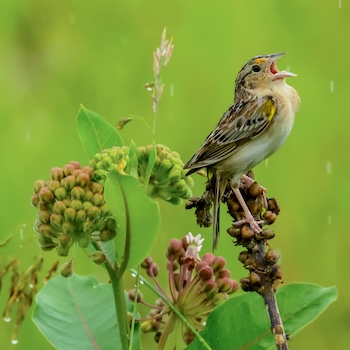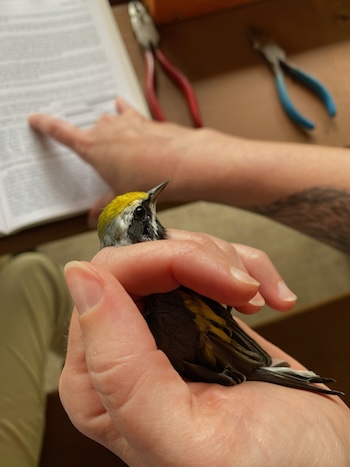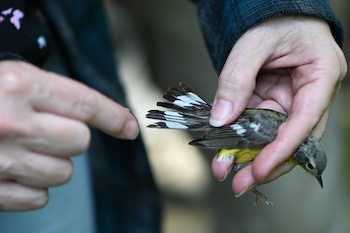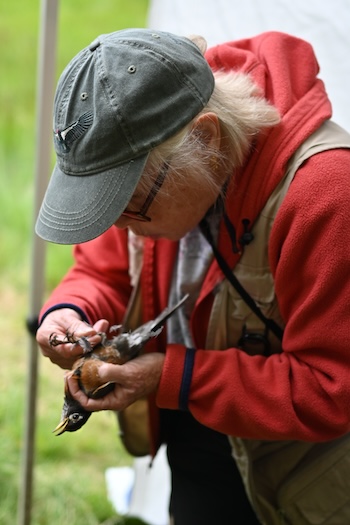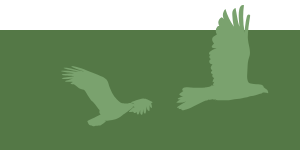
MAPS: MONITORING AVIAN PRODUCTIVITY AND SURVIVORSHIP
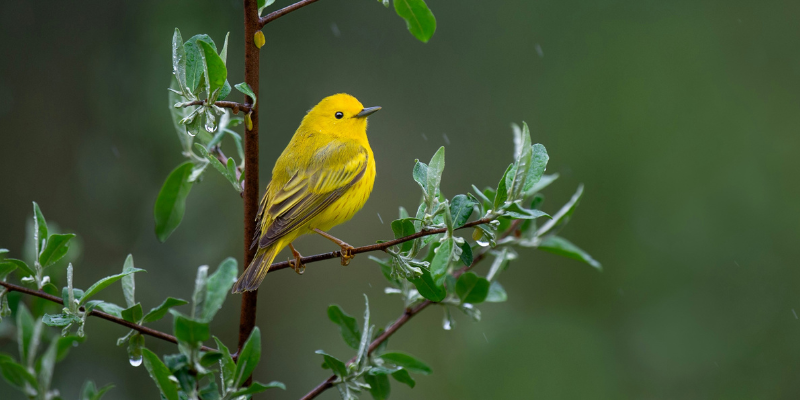
What is the MAPS Program?
The MAPS program is a continent-wide collaborative effort among public agencies, non-governmental groups, and individuals to assist the conservation of birds and their habitats through standardized bird monitoring.
Click on the 4 arrows icon to view in full screen.
MAPS bird banders collect data that can be used to estimate key demographic parameters known as vital rates, such as productivity, recruitment, and survival of individual bird species. This information helps scientists understand which life-stages may be most important in driving population change.
Since 1989, more than 1,200 MAPS stations spread across nearly every state and Canadian province have collected more than 2.5 million bird capture records.
Why is MAPS Important?
Examining vital rates can enhance the effectiveness of conservation efforts so that limited conservation dollars can be directed to the times and places in the annual cycle where they are most needed.
MAPS data provide insights into important questions such as:
- What factors drive avian population declines?
- Where are problems most acute, on the breeding or non-breeding grounds?
- What drives differences in trends between particular regions or habitats?
- What is the relationship between population change and weather, climate, or habitat loss?
- What can we do to reverse declines?
How Does MAPS Work?
MAPS stations are operated by trained and permited bird banders during the breeding season and use a system of fine mesh nets to capture birds. After the birds are banded and data is collected, they are released unharmed. Program participants follow a standardized protocol so that data from different stations or years can be compared. Stations are operated by scientists, land managers, and individuals from diverse organizations who collect information on the age, sex, body condition, and reproductive status of hundreds of species.
What have we learned from MAPS to date?
IBP and our collaborators have published more than 150 peer-reviewed papers and hundreds of reports on the vital rates of landbirds, and their relationships to climate, habitat, land management, restoration, and other environmental variables. See the sidebar at the right for some recent findings, and the bottom of this page for a complete list of peer-reviewed publications.
Using MAPS Data in Your Research
Ecologists recognize the value of long-term monitoring, but rarely have the luxury of working with vast, meticulously curated datasets. The robust and geographically-extensive data sets from MAPS and MoSI can help answer diverse questions about avian ecology.
MAPS and MoSI data are readily available for free to scientists researching important issues in bird conservation.
Do you have a research question for which MAPS or MoSI data might prove useful? To download MAPS data or to To see summaries of more than a dozen vital rates for scores of species, visit, please visit the MAPS Data Exploration Tool.
If you still have questions, or for more information about a potential collaboration, or to request MAPS or MoSI data, please contact Danielle Kaschube or Steve Albert.
Photo Credits: Top of Panel, Ray Hennessey
SELECTED PUBLICATIONS
Peer-reviewed Publications Authored by IBP Personnel
Albert, S., R. Rueda Hernandez, B.E. Hernandez-Banos, K. Ruegg, and T.B. Smith. 2025. Ampliar el monitoreo de la migración y aumentar la colaboración para la conservación de las aves migratorias Neotropicales-Nearcticas [Expanding migration monitoring and increasing collaboration for the conservation of Neotropical-Nearctic migratory birds]. Ornitología Neotropical 35:103-106. PDF
Belitz, M.W., E.A. Larsen, A.H. Hurlbert, G.J. Di Cecco, M. Neupane, L. Ries, M.W. Tingley, R.P. Guralnick, and C. Youngflesh. 2025. Potential for bird–insect phenological mismatch in a tri-trophic system. Journal of Animal Ecology 2025:00:1-12. PDF
Miller, C.V., C.M. Bossu, J.F. Saracco, D.P.L. Toews, C.S. Rushing, A. Roberto-Charron, J.A. Tremblay, R.B. Chandler, M.G. DeSaix, C.J. Fiss, J.L. Larkin, S. Haché, S. Nebel and K.C. Ruegg. 2024. Genomics-informed conservation units reveal spatial variation in climate vulnerability in a migratory bird. Molecular Ecology 33:e17199. PDF
Pyle, P. 2024. Guía de Identificación de Aves de América del Norte, Parte I, Tomo I. R. Rueda-Hernández, M. Albornoz, C. Gigena, V. and S. Guallar, Translators. Ecoval Ediciones, México.
Pyle, P. 2024. The ABA Checklist Committee in an evolving world. American Birds 75(1):34-51. PDF
Youngflesh, C., J.F. Saracco, R.B. Siegel and M.W. Tingley. 2024. Reply to: Shrinking body size may not provide meaningful thermoregulatory benefits in a warmer world. Nature Ecology and Evolution 8:390–391. Available at: https://doi.org/10.1038/s41559-023-02308-1
DeSaix, M.G., E.C. Anderson, C.M. Bossu, C.E. Rayne, T.M. Schweizer, N.J. Bayly, D.S. Narang, J.C. Hagelin, H. Lisle Gibbs, J.F. Saracco, T.W. Sherry, M.S. Webster, T.B. Smith, P.P. Marra and K.C. Ruegg. 2023. Low-coverage whole genome sequencing for highly accurate population assignment: Mapping migratory connectivity in the American Redstart (Setophaga ruticilla). Molecular Ecology 32:5528-5540. Available at: DOI: 10.1111/mec.17137
Pyle, P., L. DeCiccio, D. Gochfeld, A. Jaramillo, A.W. Kratter, M.W. Lockwood, M. Mutchler, and D. Sibley. 2023. 34th Report of the ABA Checklist Committee 2023. North American Birds 74(2):4-9. PDF
Pyle, P., S.N.G. Howell, D.I. Rogers, and C. Corben. 2024. Moult terminology: envisioning an evolutionary approach. Journal of Avian Biology 2024:e03169. PDF
Youngflesh, C., G.A. Montgomery, J.F. Saracco, D.A.W. Millerd, R.P. Guralnicke, A.H. Hurlbert, R.B. Siegel, R. LaFrancee, and M.W. Tingley. 2023. Demographic consequences of phenological asynchrony for North American songbirds. Proceedings of the National Academy of Sciences 28:e2221961120. PDF
Albert, S., C.J. Ralph, A. Hannuksela, W.H. Sakai, A. Nelson, C. Kondrat, M. Krzywicki, H. Garrod, C. Woolley, and C. Stuyck. 2022. Is the term "bird banding" obsolete? And what should we do about it? North American Bird Bander 47:199-200. PDF
Kaschube, D.R., J.F. Saracco, C. Ray, C.M. Godwin, K.R. Foster, and P. Pyle. 2022. Minimum capture-recapture rates and years of banding station operations to obtain reliable adult annual survival estimates. Journal of Field Ornithology 93:7. PDF
Pyle, P. 2022. Identification Guide to North American Birds, Part 1, 2nd Edition. Slate Creek Press, Forest Knolls, California. 698 pp.
Pyle, P., M. Gahbauer, E.I. Johnson, T.B. Ryder, and J.D. Wolfe. 2022. Application of a global age-coding system (WRP), based on molts and plumages, for use in demographic and other studies of birds. Ornithology 139:1-12. PDF
Saracco, J.F., P. Pyle, D.R. Kaschube, M. Kohler, C.M. Godwin, and K.R. Foster. 2022. Demographic declines over time and variable responses of breeding bird populations to human footprint in the Athabasca Oil Sands Region, Alberta, Canada. Ornithological Applications 125:1-14. PDF
Saracco, J.F., R.L. Cormier, D.L. Humple, S. Stock, R. Taylor, and R.B. Siegel. 2022. Demographic responses to climate-driven variation in habitat quality across the annual cycle of a migratory bird species. Ecology and Evolution 2022;12:e8934. PDF
Youngflesh, C., J.F. Saracco, R.B. Siegel, and M.W. Tingley. 2022. Abiotic conditions shape spatial and temporal morphological variation in North American birds. Nature Ecology and Evolution. DOI 10.1038/s41559-022-01893-x.
Bay, R.A., D.S. Karp, J.F. Saracco, W.R.L. Anderegg, L.O. Frishkoff, D. Wiedenfeld, T.B. Smith, and K. Ruegg. 2021. Genetic variation reveals individual-level climate tracking across the annual cycle of a migratory bird. Ecology Letters 2021:1-10. For a copy of this publication, please contact Jim Saracco.
Carnes, B.H., C.M. Godwin, K.R. Foster, and P. Pyle. 2021. Clarification of molt strategies in three Empidonax flycatchers. The Wilson Journal of Ornithology 133:34-42. PDF
Pyle, P., K.R. Foster, C.M. Godwin, D.R. Kaschube, and J.F. Saracco. 2020. Yearling proportion correlates with habitat structure in a boreal forest landbird community. PeerJ 8:e8898. PDF
Ruegg, K.C., R.J. Harrigan, J.F. Saracco, T.B. Smith, and C.M. Taylor. 2020. A genoscapennetwork model for conservation prioritization in a migratory bird. Conservation Biology 34:1482-1491. For a copy of this publication, please contact Jim Saracco.
Saracco, J.F., and M. Rubenstein. 2020. Integrating broad-scale data to assess demographic and climatic contributions to population change in a declining songbird. Ecology and Evolution 10:1804-1816. PDF
Carnes, B., and A. Ash. 2019. Evidence for suspension of prebasic molt in a White-eyed Vireo. Western Birds 50:52-54. PDF
Roy, C., N.L. Michel, C.M. Handel, S.L. Van Wilgenburg, J.C. Burkhalter, K.E.B. Gurney, D.J. Messmer, K. Prince, C.S. Rushing, J.F. Saracco, R. Schuster, A.C. Smith, P.A. Smith, P. Sólymos, L.A. Venier, and B. Zuckerberg. 2019. Monitoring boreal avian populations: How can we estimate trends and trajectories from noisy data? Avian Conservation and Ecology 14:8. PDF
Saracco, J.F., R.B. Siegel, L. Helton, S. Stock, and D. DeSante. 2019. Phenology and productivity in a montane bird assemblage: trends and responses to elevation and climate variation. Global Change Biology 2019:25;985-086. PDF
Albert, S., K. Ruegg, and R.B. Siegel. 2018. El uso de marcadores intrínsicos y extrínsicos para enlazar poblaciones de aves a través de las Américas [Use of intrinsic and extrinsic markers to link bird populations across the Americas]. Zeledonia 22:8-20. PDF
DeSante, D.F., Kaschube, D.R., and Saracco, J.F. 2018. Population changes and their demographic drivers in landbirds of western North America: an assessment from the Monitoring Avian Productivity and Survivorship program. Pages 269-293 in: W.D. Shuford, R.E. Gill Jr., and C.M. Handel, eds. Trends and Traditions: Avifaunal Change in Western North America. Studies of Western Birds No. 3.
Pyle, P., J.F. Saracco, and D.F. DeSante. 2018. SUPPLEMENTAL MATERIAL for Evidence of widespread movements from breeding to molting grounds by North American landbirds - The Auk: Ornithological Advances 135:506-520. PDF
Pyle, P., J.F. Saracco, and D.F. DeSante. 2018. Evidence of widespread movements from breeding to molting grounds by North American landbirds. The Auk: Ornithological Advances 135:506-520. PDF
Rueda-Hernandez, R., S. Guallar, A. Ruiz-Sanchez, and P. Pyle. 2018. The molt issue: where do we go from now? Ornitología Neotropical 29:S1-S2. PDF
Ruegg, K., R.A. Bay, E.C. Anderson, J.F. Saracco, R.J. Harrigan, M. Whitfield, E.H. Paxton, and T.B. Smith. 2018. Ecological genomics predicts climate vulnerability in an endangered southwestern songbird. Ecology Letters 21:1085-1096. For a copy of this publication, please contact Jim Saracco.
Saracco, J.F., S.M. Fettig, G.L. San Miguel, D.W. Mehlman, B.E. Thompson, and S.K. Albert. 2018. Avian demographic responses to drought and fire: a community-level perspective. Ecological Applications 28:1773-81. For a copy of this publication, please contact Jim Saracco.
Wilson, S., J.F. Saracco, R. Krikun, D.T. Tyler Flockhart, C.M. Godwin, and K.R. Foster. 2018. Drivers of demographic decline across the annual cycle of a threatened migratory bird. Scientific Reports:7316. PDF
Ahrestani, F.S., J.F. Saracco, J.R. Sauer, K.L. Pardieck, and J.A. Royle. 2017. An integrated population model for bird monitoring in North America. Ecological Applications 27:916-924. (For a copy of this publication, please contact Jim Saracco.)
Carnes, B.H. 2017. Age determination of Swainson's Thrush using the distal marginal coverts. North American Bird Bander 42:104-107.
Lai, P., P. Pyle, K.R. Foster, and C.M. Godwin. 2017. Identifying sparrows in juvenile plumage. Birding 49(6):62-76. PDF
Albert, S., D. DeSante, R. Siegel, D. Kaschube, and J. Saracco. 2016. Monitoring landbirds in national parks: understanding populations, migratory connectivity, and climate change. Pages 11-17 in: S. Weber, editor. Engagement, Education, and Expectations — The Future of Parks and Protected Areas: Proceedings of the 2015 George Wright Society Conference on Parks, Protected Areas, and Cultural Sites. Hancock, Michigan: George Wright Society. PDF
Albert, S.K., D.F. DeSante, D.R. Kaschube, and J.F. Saracco. 2016. MAPS (Monitoring Avian Productivity and Survivorship) data provide inferences on demographic drivers of population trends for 158 species of North American landbirds. North American Bird Bander 41:133-140. PDF
Foster, K.R., C.M. Godwin, P. Pyle, and J.F. Saracco. 2016. Reclamation and habitat-disturbance effects on landbird abundance and productivity indices in the oil sands region of northeastern Alberta, Canada. Restoration Ecology 25:532-538. PDF
Nordell, C.J., S. Haché, E.M. Bayne, P.M. Sólymos, K.R. Foster, C.M. Godwin, R. Krikun, P. Pyle, and K.A. Hobson. 2016. Within-site variation in feather stable hydrogen isotope (δ2Hf) values of boreal songbirds: implications for assignment to molt origin. PLoS ONE 11:e0163957. (For a copy of this publication, please contact Peter Pyle.)
Rushing, C.S., T.B. Ryder, A.L. Scarpignato, J.F. Saracco, and P.P. Marra. 2016. Using demographic attributes from long-term monitoring data to delineate population structure. The Journal of Applied Ecology 53:491-500. (For a copy of this publication, please contact Jim Saracco.)
Siegel, R.B., R. Taylor, J.F. Saracco, L. Helton, and S. Stock. 2016. GPS-tracking reveals non-breeding locations and apparent molt migration of a Black-headed Grosbeak. Journal of Field Ornithology 87:196-203. PDF
DeSante, D.F., D.R. Kaschube, and J.F. Saracco. 2015. Vital rates of North American landbirds. The Institute for Bird Populations. www.VitalRatesOfNorthAmericanLandbirds.org.
George, T.L., R.J. Harrigan, J.A. LaManna, D.F. DeSante, J.F. Saracco, and T.B. Smith. 2015. Persistent impacts of West Nile virus on North American bird populations. Proceedings of the National Academy of Sciences 112(46):14290-14294. PDF
Keller, D.C., P.R. Fresquez, L.A. Hansen, and D.R. Kaschube. 2015. Avian community composition in response to high explosive testing operations at Los Alamos National Laboratory in northern New Mexico. The Journal of Environmental Protection 6:1442-1453. PDF
Pyle, P., C.M. Godwin, and K.R. Foster. 2015. Identifying juvenile warblers: The fun really begins here. Birding 47(6):58-69. PDF
Rowan, E., R.B. Siegel, D.R. Kaschube, and S. Stock. 2014. North American longevity records for nine landbird species monitored at Yosemite National Park's MAPS stations. North American Bird Bander 39:153-159. PDF
Ruegg, K., E. Anderson, K. Paxton, V. Apkenas, S. Lao, R.B. Siegel, D.F. DeSante, F. Moore, and T. Smith. 2014. Mapping migration in a songbird using high-resolution genetic markers. Molecular Ecology 23:5726-5739. PDF
Rushing, C.S., T.B. Ryder, J. Saracco, and P.P. Marra. 2014. Assessing migratory connectivity for a long-distance migratory bird using multiple intrinsic data sources. Ecological Applications 24:445-456. PDF
Rundel, C.W., M.B. Wunder, A.H. Alvarado, K.C. Ruegg, R. Harrington, A. Schuh, J.F. Kelly, R.B. Siegel, D.F. DeSante, T.B. Smith, and J. Novembre. 2013. Novel statistical methods for integrating genetic and stable isotope data to infer individual-level migratory connectivity. Molecular Ecology 22:4163-4176. PDF
LaManna, J.A., T.L. George, J.F. Saracco, M.P. Nott, and D.F. DeSante. 2012. El Niño-Southern Oscillation influences annual survival of a migratory songbird at a regional scale. The Auk 129:734-743. PDF
Saracco, J.F., J.A. Royle, D.F. DeSante, and B. Gardner. 2012. Spatial modeling of survival and residency and application to the Monitoring Avian Productivity and Survivorship Program. The Journal of Ornithology 152 (Supplement 2):S469-S476. PDF
De la Hera, I., D.F. DeSante, and B. Mila. 2011. Feather growth rate and mass in Nearctic passerines with variable migratory behavior and molt pattern. The Auk 129:222-230. PDF
Fuller, T., S. Saatchi, E. Curd, E. Toffelmier, H. Thomassen, W. Buermann, D.F. DeSante, M.P. Nott, J.F. Saracco, C.J. Ralph, J. Pollinger, J. Alexander, and T.B. Smith. 2010. Mapping the risk of avian influenza in wild birds in the U.S. BMC Infectious Diseases 10:187. PDF
Saracco, J.F., J.A. Royle, D.F. DeSante, and B. Gardner. 2010. Modeling spatial variation in avian survival and residency probabilities. Ecology 91:1885-1891. PDF
Stock S.L., R.B. Siegel, and D.R. Kaschube. 2010. Declines in Yosemite’s bird populations. Pages 117-124 in: S. Weber, editor. Rethinking Protected Areas in a Changing World: Proceedings of the 2009 George Wright Society Biennial Conference on Parks, Protected Areas, and Cultural Sites. PDF
DeSante, D.F., and D.R. Kaschube. 2009. The Monitoring Avian Productivity and Survivorship (MAPS) Program 2004, 2005, and 2006 report. Bird Populations 9:86-169. PDF
DeSante, D.F., and J.F. Saracco. 2009. Power of the MAPS Program to detect differences and trends in survival and a vision for program expansion. Bird Populations 9:42-75. PDF
DeSante, D.F., D.R. Kaschube, J.F. Saracco, and J.E. Hines. 2009. Power to detect differences and trends in apparent survival rates. Bird Populations 9:29-41. PDF
Froehlich, D. 2009. Ageing North American landbirds by molt limits and plumage criteria: a photographic companion guide to the Identification Guide to North American Birds, Part I. Slate Creek Press, Bolinas, CA. PDF
Robinson, R.A., R. Julliard, and J.F. Saracco. 2009. Constant effort: studying avian population processes through standardised ringing. Ringing and Migration 24:199-204. PDF
Saracco, J.F., D.F. DeSante, M.P. Nott, and D.R. Kaschube. 2009. Using the MAPS and MoSI Programs to monitor landbirds and inform conservation. Pages 651-658 in: T.D. Rich, C.D. Thompson, D. Demarest, and C. Arizmendi, editors. Proceedings of the Fourth International Partners in Flight Conference: Tundra to Tropics. University of Texas-Pan American Press. PDF
Saracco, J.F., D.F. DeSante, M.P. Nott, W.M. Hochachka, S. Kelling, and D. Fink. 2009. Integrated bird monitoring and the Avian Knowledge Network: using multiple data resources to understand spatial variation in demographic processes and abundance. Pages 659-661 in: T.D. Rich, C.D. Thompson, D. Demarest, and C. Arizmendi, editors. Proceedings of the Fourth International Partners in Flight Conference: Tundra to Tropics. University of Texas-Pan American Press. PDF
Saracco, J.F., D.F. DeSante, and D.R. Kaschube. 2008. Assessing landbird monitoring programs and demographic causes of population trends. The Journal of Wildlife Management 72:1665-1673. PDF
Siegel, R.B., R.L. Wilkerson, and D.F. DeSante. 2008. Extirpation of the Willow Flycatcher from Yosemite National Park. Western Birds 39:8-21. PDF
DeSante, D.F., and D.R. Kaschube. 2007. The Monitoring Avian Productivity and Survivorship (MAPS) Program 2002 and 2003 report. Bird Populations 8:46-115. PDF
Burton, K., and P. Pyle. 2006. Some unexpected primary-covert molt limits. North American Bird Bander 31:121. PDF
DeSante, D.F., and D.R. Kaschube. 2006. The Monitoring Avian Productivity and Survivorship (MAPS) Program 1999, 2000, and 2001 report. Bird Populations 7:23-89. PDF
DeSante, D.F. 2005. Suggestions for planning a migration-monitoring network based on the experience of establishing and operating the MAPS Program. In: C.J. Ralph and E.H. Dunn, editors. Using Mist Nets to Monitor Bird Populations. U.S.D.A. Forest Service General Technical Report PSW-GTR-191. PDF
DeSante, D.F., M.P. Nott, and D.R. Kaschube. 2005. Monitoring, modeling, and management: why base avian monitoring on vital rates and how should it be done? Pages 795-804 in: C.J. Ralph and T.D. Rich, editors. Bird Conservation Implementation and Integration in the Americas. U.S.D.A. Forest Service General Technical Report PSW-GTR-191. PDF
Burton, K.M., and D.F. Desante. 2004. Effects of mist-netting frequency on capture rates at MAPS stations. Studies in Avian Biology 29:7-11. PDF
DeSante, D.F., J.F. Saracco, D.R. O'Grady, K.M. Burton, and B.L. Walker. 2004. Some methodological considerations of the Monitoring Avian Productivity and Survivorship Program. In: C.J. Ralph and E.H. Dunn, editors. Using Mist Nets to Monitor Bird Populations. Studies in Avian Biology 29:28-45.
Nott M.P., and D.F. DeSante. 2002. Demographic monitoring and the identification of transients in mark-recapture models. In: J.M. Scott, P.J. Heglund, M. Morrison, M. Raphael, J. Haufler, B. Wall, editors. Predicting Species Occurrences: Issues of Scale and Accuracy. Island Press. Covello, CA. PDF
Nott, M.P., D.F. DeSante, R.B. Siegel, and P. Pyle. 2002. Influences of the El Nino/Southern Oscillation and the North Atlantic Oscillation on avian productivity in forests of the Pacific Northwest of North America. Global Ecology and Biogeography 11:333-342. PDF
DeSante, D.F., M.P. Nott, and D.R. O'Grady. 2001. Identifying the proximate demographic cause(s) of population change by modeling spatial variation in productivity, survivorship, and population trends. Ardea 89:185-208. PDF
Siegel, R.B., M.P. Nott, and D.F. DeSante. 2001. Using point counts to establish conservation priorities: How many visits are optimal? Journal of Field Ornithology 72:228-235. PDF
DeSante, D.F., and D.R. O’Grady. 2000. The Monitoring Avian Productivity and Survivorshop (MAPS) Program 1997 and 1998 annual report. Bird Populations 5:49-101.
Burton, K.M., and D.F. DeSante. 1999. Volunteers and training in MAPS. In: R. Bonney, D.N. Pashley, R.J. Cooper, and L. Niles, editors. Strategies for Bird Conservation: The Partners in Flight Planning Process. Cornell Lab of Ornithology. PDF
DeSante, D.F. 1999. Patterns of productivity and survivorship from the MAPS Program. In: R. Bonney, D.N. Pashley, R.J. Cooper, and L. Niles, editors. Strategies for Bird Conservation: The Partners in Flight Planning Process. Cornell Lab of Ornithology. PDF
DeSante, D.F., D.R. O'Grady, and P. Pyle. 1999. Measures of productivity and survival derived from standardised mist-netting are consistent with observed population changes. Bird Study 46 (suppl.): S178-188. PDF
Rosenberg, D.K., D.F. DeSante, and J.E. Hines. 1999. Monitoring survival rates of landbirds at varying spatial scales: an application of the MAPS Program. Pages 178-184 in: Strategies for Bird Conservation: the Partners in Flight Planning Process. Proceedings of the 3rd Partners in Flight Workshop. October 1-5, 1995, Cape May, NJ. PDF
Buckley, P.A., C.M. Francis, P. Blancher, D.F. Desante, C.S. Robbins, G. Smith, and P. Cannell. 1998. The North American bird banding program: into the 21st Century. Journal of Field Ornithology 69:511-692. PDF
DeSante, D.F., and D.K. Rosenberg. 1998. What do we need to monitor in order to manage landbirds? Pages 93-106 in: J.M. Marzluff, and R. Sallabanks, editors. Avian Conservation: Research and Management. Island Press, Washington, D.C. PDF
DeSante, D.F., D.R. O'Grady, K.M. Burton, P. Velez, D. Froehlich, E.E. Feuss, H. Smith, and E.D. Ruhlen. 1998. The Monitoring Avian Productivity and Survivorship (MAPS) Program sixth and seventh annual reports (1995 and 1996). Bird Populations 4:69-122.
Pyle, P. 1997. Identification Guide to North American Birds. Part 1. Slate Creek Press, Bolinas, CA. 742 pp.
DeSante, D.F., K.M. Burton, and D.R. O’Grady. 1996. The Monitoring Avian Productivity and Survivorship (MAPS) Program fourth and fifth annual report (1993 and 1994). Bird Populations 3:67-120.
Ralph, C.J., G.R. Geupel, P. Pyle, T.E. Martin, D.F. DeSante, and B. Milá. 1996. Manual de métodos de campo para el monitoreo de aves terrestres. General Technical Report PSW-GTR-159. Albany, CA: Pacific Southwest Research Station, Forest Service, U.S. Department of Agriculture. PDF
DeSante, D.F. 1995. Suggestions for future directions for studies of marked migratory landbirds from the perspective of a practitioner in population management and conservation. The Journal of Applied Statistics 22:949-965.
DeSante, D.F., K.M. Burton, J.F., Saracco, and B.L. Walker. 1995. Productivity indices and survival-rate estimates from MAPS, a continent-wide programme of constant-effort mist-netting in North America. The Journal of Applied Statistics 22:935-947.
DeSante, D.F., and T.L. George. 1994. Population trends in the landbirds of western North America. Pages 173-190 in: J.R. Jehl and N.K. Johnson, editors. A Century of Avifaunal Change in Western North America. Studies in Avian Biology No. 15. PDF
DeSante, D.F., K.M. Burton. 1994. The Monitoring Avian Productivity and Survivorship (MAPS) Program third annual report (1992). Bird Populations 2:62-89.
DeSante, D.F., K.M. Burton, and O.E. Williams. 1993. The Monitoring Avian Productivity and Survivorship (MAPS) Program second annual report (1990-1991). Bird Populations 1:68-97.
Ralph, C.J.. G. Geupel, P. Pyle, T.E. Martin, and D.F. DeSante. 1993. Handbook of field methods for monitoring landbirds. U.S.D.A. Forest Service General Technical Report PSW-GTR-144. PDF
DeSante, D.F. 1992. Monitoring Avian Productivity and Survivorship (MAPS): a sharp, rather than blunt, tool for monitoring and assessing landbird populations. Pages 511-521 in: D.R. McCullough and R.H. Barrett, editors. Wildlife 2001: Populations. Elsevier Applied Science, London, UK. PDF
Pyle, P., S.N.G. Howell, R.P. Yunick, and D.F. DeSante. 1987. Identification Guide to North American Passerines. Slate Creek Press, Bolinas, CA.
Peer-reviewed Publications by Other Researchers
Sen, B., and H.R. Akcakaya. 2022. Inter-specific variability in demographic processes affects abundance-occupancy relationships. Oecologia 13 January 2022. PDF
Winger, B.M., and T.M. Pegan. 2021. Migration distance is a fundamental axis of the slow-fast continuum of life history in boreal birds. Ornithology 138:11-18. PDF
Glass, A.J., A.J. Caven, D. Kim, M.O. Sutton, and N. Arcilla. 2020. Climate change and land management implications for a declining Neotropical migratory songbird breeding in the North American Great Plains. Avian Conservation and Ecology 15:4. PDF
Ng, A.M.B., M. Pontius, S.L. De Ruiter, and D.S. Proppe. 2020. Noise, avian abundance, and productivity at banding stations across the Continental United States. Avian Conservation and Ecology 15:4. Link to Paper
Rosamond, K.M., S. Goded, A. Soultan, R.H. Kaplan, A.J. Glass, D.H. Kim, and N. Arcilla. 2020. Not singing in the rain: linking precipitation increases and brood parasitism vulnerability to migratory songbird declines. Frontiers in Ecology and Evolution 2020:fevo.2020.536769.
Scholer, M.N., M. Strimas-Mackey, and J.E. Jankowski. 2020. A meta-analysis of global avian survival across species and latitude. Ecology Letters 2020:1-5.
Scholer, M.N., M. Strimas-Mackey, and J.E. Jankowski. 2020. A meta-analysis of global avian survival across species and latitude. Ecology Letters 10.1111/ele.13573. PDF
Wolfe, J.D., J.D. Alexander, J.L. Stephens, and C.J. Ralph. 2019. A novel approach to understanding bird communities using informed diversity estimates at local and regional scales in northern California and southern Oregon. Ecology and Evolution 1:12. PDF
Ryu, H.Y., K.T. Shoemaker, É. Kneip, A.M. Pidgeon, P.J. Heglund, B.L. Bateman, W.E. Thogmartin, and H.R. Akçakaya. 2016. Developing population models with data from marked individuals. Biological Conservation 197:190-199.
Senda, M., N. Nakamura, and K. Ozaki. 2016. Annual report of the Monitoring Avian Productivity and Survivorship (MAPS) Program in Fukushima, Japan (2012 to 2015). The Journal of the Yamashina Institute for Ornithology 47:140-155. (In Japanese with abstract and tables in English). PDF
Brown, L.M., and C.H. Graham. 2015. Demography, traits and vulnerability to urbanization: Can we make generalizations? The Journal of Applied Ecology 52:1455–1464. PDF
Su, M.R., and R.S. Lin. 2015. Sexing, aging and molt patterns of White-tailed Robin Cinclidium leucurum monti. The Taiwan Journal of Biodiversity 17:287-300. (In Chinese with English abstract) PDF
Hsu, T.C., and H.J. Shiu. 2014. A comparison of bird point count and mist netting used in a lowland shrub in southern Taiwan. The Taiwan Journal of Biodiversity 16:51-61. (In Chinese with English abstract) PDF
Yang, C.Y., S.P. Yo, and R.S. Lin. 2014. Estimation of survival rate for Alcippe morrisonia, Alcippe brunnea, Stachyris ruficeps, and Pomatorhinus ruficollis by using capture-recapture method. M.S. Thesis, Department of Life Sciences, National Chung Hsing University, Taichung, Taiwan. PDF
Lin, R.S., C.Y. Yang, Y.W. Mei, and H.Y. Sung. 2013. Preliminary investigation of the prevalence of avian pox-like lesions in resident passerines in Taiwan. The Taiwan Journal of Biodiversity 15:219-231. (In Chinese with English abstract) PDF
Wolfe, J.D., E.I. Johnson, P.C. Stouffer, F. Owens, E. Deleon, E. Liffmann, K. Brzeski, S. Utley, D. Mooney, C. Coco, and G. Grandy. 2013. Annual survival of birds captured in a habitat island bordered by the urban matrix of Baton Rouge, LA. The Southeastern Naturalist 12:492-499. PDF
Akresh, M.E., K. Dinse, J. Foufopoulos, S.C. Schubel, and T. Kowalczyk. 2009. Passerine breeding and post-fledgling habitat use in riparian and upland temperate forests of the American Midwest. The Condor 111:756-762. PDF
Jennings, S., T. Gardali, N.E. Seavy, and G.R. Geupel. 2009. Effects of mist netting on reproductive performance of Wrentits and Song Sparrows in central coastal California. The Condor 111:488–496. PDF
Alexander, J.D., C.J. Ralph, K. Hollinger, and B. Hogoboom. 2004. Using a wide-scale landbird monitoring network to determine landbird distribution and productivity in the Klamath-Siskiyou region. Pages 33-41 in: K.L. Mergenthaler, J.E. Williams, and J. Jules, editors. Proceedings of the Second Conference on Klamath-Siskiyou Ecology, Klamath Falls, OR. PDF
Donnelly, R., and J.M. Marzluff. 2003. Importance of reserve size and landscape context to urban bird conservation. Conservation Biology 18:734-745. PDF
Bart, J., C. Kepler, P. Sykes, and C. Boceti. 1999. Evaluation of mist-net sampling as an index to productivity in Kirtland's Warblers. The Auk 116:1147-1151. PDF
Tautin, J., L. Metras, and G. Smith. 1999. Large-scale studies of marked birds in North America. Bird Study 46:S271-S278. PDF
Other Publications and Reports
Zulian, V., and C. Youngflesh. 2025. Geography, environmental conditions, and life history, shape patterns of within-population phenotypic variation in North American Birds. Ecology Letters 28:e70244. PDF
Pyle, P. 2023. The Mentor's Corner. The Fledgling Issue 3:31-33. PDF
Pyle, P., M. Gustafson, A. Jaramillo, T. Johnson, A.W. Kratter, A. Lang, M.W. Lockwood, M. Mutchler, and D. Sibley. 2022. 33rd Report of the ABA Checklist Committee 2022. North American Birds 73(2):18-23. PDF
Kaschube, D.R., B. Carnes, and S. Albert. 2021. MAPS program demographic monitoring at Fort A.P. Hill, Virginia: report for the 2020 field season. The Institute for Bird Populations, Petaluma, CA.
Kaschube, D.R., C. Ray, R. Taylor, R. Keith, B. Keith, J. Brenneman, and S. Albert 2020. An analysis of point count and demographic monitoring data from Fort Custer Training Center and the Kalamazoo Nature Center 1990-2019. Report by The Institute for Bird Populations, The Kalamazoo Nature Center, and the Fort Custer Training Center.
Pyle, P., M. Gustafson, T. Johnson, A. Kratter, A. Lang, M.W. Lockwood, K. Nelson, and D. Sibley. 2021. 32nd report of the ABA Checklist Committee. North American Birds 72(2):10-17. PDF
Albert, S., D.R. Kaschube, C. Ray, R. Taylor, L. Schofield, and B.H. Carnes. 2020. Landbird monitoring at Fort A.P. Hill, Virginia: report for the 2019 field season. The Institute for Bird Populations, Petaluma, CA.
Albert, S., L. Helton, and D. Kaschube. 2020. The Monitoring Avian Productivity and Survivorship (MAPS) program on the Wild and Scenic portions of the Merced River, California: 2019 annual report. The Institute for Bird Populations, Point Reyes Station, CA.
Helton, L.W., R.B. Siegel, D.R. Kaschube, and S.L. Stock. 2020. The 2019 annual report of the Monitoring Avian Survivorship and Productivity (MAPS) Program in Yosemite National Park. IBP Report to Yosemite National Park.
Kaschube, D.R., J.F. Saracco, C. Ray, and P. Pyle. 2020. Minimum estimated sample sizes to obtain reliable vital-rate estimates using Boreal MAPS data. The Institute for Bird Populations, Petaluma, CA.
Kaschube, D.R., L. Helton, R. Taylor, P. Pyle, and S. Albert. 2020. The 2018-19 Report of the Monitoring Avian Productivity and Survivorship (MAPS) Program on the Audubon Canyon Ranch Cypress Grove Preserve. The Institute for Bird Populations, Petaluma, CA.
Walker, M. 2020. Catch, release, catch again: Is bird banding still valuable in the 21st century? Birding 53(2):44-49. PDF
Albert, S., D.R. Kaschube, L. Helton, J. Reese, and M. DeSaix. 2019. The Monitoring Avian Productivity and Survivorship (MAPS) Program on the Wild and Scenic Portions of the Merced River, California: 2018 Annual Report. The Institute for Bird Populations, Point Reyes Station, CA.
Helton, L.W., R.B. Siegel, D.R. Kaschube, and S. Stock. 2019. The 2018 Annual Report of the Monitoring Avian Productivity and Survivorship (MAPS) Program in Yosemite National Park. The Institute for Bird Populations, Point Reyes Station, CA.
Albert, S., C. Ray, J. Schillaci, and L. Schofield. 2018. The Fort Bragg landbird monitoring project: report for the 2017 field season. The Institute for Bird Populations, Point Reyes Station, CA. PDF
P. Pyle, D. Roche, Z. Emery, E. Fishel, H.M. Todaro, M. Wayne, J. Wong, K. Kayano, D. Kaschube, and L. Helton. 2018. The Tropical Monitoring Avian Productivity and Survivorshop (TMAPS) Program in American Samoa: 2018 Report. The Institute for Bird Populations, Point Reyes Station, CA. PDF
Albert, S., D. Kaschube, and R. Taylor. 2017. The 2016 Annual Report of the Monitoring Avian Productivity and Survivorship (MAPS) Program on Fort Bragg, North Carolina. The Institute for Bird Populations, Point Reyes Station, CA. PDF
Kaschube, D.R., and S. Albert. 2017. The Monitoring Avian Productivity and Survivorship (MAPS) Program at Audubon Canyon Ranch, Cypress Grove Research Center. The Institute for Bird Populations, Point Reyes Station, CA.
Marra, P.P., T.B. Ryder, S. Sillett, M. Betts, R. Siegel, J. Saracco, and R. Fischer. 2017. Using a hierarchical approach to model regional source-sink dynamics for neotropical-nearctic songbirds to inform management practices on Department of Defense installations. U.S. Department of Defense Strategic Environmental Research and Development Program, Final Report. PDF
Gahbauer, M.A., S. Duval, and D. Davey. 2016. McGill Bird Observatory ten-year report 2005-2014. McGill Bird Observatory, Montreal, Quebec, Canada.
Kaschube, D.R., S. Albert, L. Helton, and R. Taylor. 2016. The 2015 Annual Report of the Monitoring Avian Productivity and Survivorship (MAPS) Program on Fort Bragg, North Carolina. The Institute for Bird Populations, Point Reyes Station, CA. PDF
Pyle, P. 2016. Rock or Purple Sandpiper? An evaluation of a California vagrant. The Institute for Bird Populations, Petaluma, California. PDF
DeSante, D.F., K.M. Burton, P. Velez, D. Froehlich, and D.R. Kaschube. 2015. MAPS Manual: 2015 Protocol. The Institute for Bird Populations, Point Reyes Station, CA. PDF
Gahbauer, M. 2015. McGill Bird Observatory annual program report 2014. McGill Bird Observatory, Montreal, Quebec, Canada. PDF
Helton, L.W., R.B. Siegel, D.R. Kaschube, and S. Stock. 2015. The 2014 annual report of the Monitoring Avian Productivity and Survivorship (MAPS) Program in Yosemite National Park. The Institute for Bird Populations, Point Reyes Station, CA. PDF
Su, M.R., J.H. Chen, S.S. Chen, H.I. Syu, D.S. Hu, L.L. Wu, Y.Z. Cai, S.H. Wu, P.J. Lin, G.J. Hong, J.L. Lai, and R.S. Lin. 2015. The 2014 annual report of the Monitoring Avian Productivity and Survivorship (MAPS) Program in Taiwan. The Endemic Species Research Institute, Nantou, Taiwan. (In Chinese with English abstract) PDF
Su, M.R., J.H. Chen, S.S. Chen, H.I. Syu, D.S. Hu, L.L. Wu, Y.Z. Cai, S.H. Wu, P.J. Lin, J.L. Lai, and R.S. Lin. 2015. The 2015 annual report of the Monitoring Avian Productivity and Survivorship (MAPS) Program in Taiwan. The Endemic Species Research Institute, Nantou, Taiwan. (In Chinese with English abstract) PDF
Corcoran, R., C. Trussell, and R. MacIntosh. 2014. Monitoring avian productivity and survivorship on Kodiak Island, Alaska, 2010-2014. Refuge report no. 2014.7, Kodiak National Wildlife Refuge. U.S. Fish and Wildlife Service, Kodiak, AK. PDF
Rowan, E., R.B. Siegel, D.R. Kaschube, and S. Stock. 2014. The 2013 Annual Report of the Monitoring Avian Productivity and Survivorship (MAPS) Program in Yosemite National Park. The Institute for Bird Populations, Point Reyes Station, CA. PDF
Song, S.Y., J.H. Chen, S.S. Chen, M.R. Su, H.I. Syu, D.S. Hu, L.L. Wu, Y.Z. Cai, R.C. Jhang, S.H. Wu, and R.S. Lin. 2014. The 2013 annual report of the Monitoring Avian Productivity and Survivorship (MAPS) Program in Taiwan. The Endemic Species Research Institute, Nantou, Taiwan. (In Chinese with English abstract) PDF
Gahbauer, M.A. 2013. McGill Bird Observatory annual program report 2013. McGill Bird Observatory, Montreal, Quebec, Canada. PDF
Rowan, E.R., D.R. Kaschube, R.B. Siegel, and S. Stock. 2013. The 2012 annual report of the Monitoring Avian Productivity and Survivorship (MAPS) Program in Yosemite National Park. Report to Yosemite National Park. The Institute for Bird Populations, Point Reyes Station, CA. PDF
Song, S.Y., J.H. Chen, S.S. Chen, M.R. Su, H.I. Syu, D.S. Hu, L.L. Wu, Y.Z. Cai, R.C. Jhang, Z.C. Syu, and R.S. Lin. 2013. The 2012 annual report of the Monitoring Avian Productivity and Survivorship (MAPS) Program in Taiwan. The Endemic Species Research Institute, Nantou, Taiwan. (In Chinese with English abstract) PDF
Gahbauer, M.A. 2012. McGill Bird Observatory annual program report 2012. McGill Bird Observatory, Montreal, Quebec, Canada. PDF
Siegel, R.B., and D.R. Kaschube. 2012. Evaluating the capacity of the Monitoring Avian Productivity and Survival (MAPS) and Monitoreo de Sobrevivencia Invernal (MoSI) Programs to monitor hummingbird populations. Report to the Hummingbird Monitoring Network. The Institute for Bird Populations, Point Reyes Station, CA.
Siegel, R.B., and D.R. Kaschube. 2012. Landbird monitoring results from the Monitoring Avian Productivity and Survivorship (MAPS) Program in the Sierra Nevada. Report to U.S.D.A. Forest Service Pacific Southwest Region. The Institute for Bird Populations, Point Reyes Station, CA. PDF
Siegel, R.B., J.F. Saracco, R.L. Wilkerson, and S. Stock. 2012. Long-term demographics of Yosemite’s songbirds: an analysis of data from the Monitoring Avian Productivity and Survivorship (MAPS) Program in Yosemite National Park. Report to Yosemite National Park. The Institute for Bird Populations, Point Reyes Station, CA. PDF
Song, S.Y., J.H. Chen, S.S. Chen, M.R. Su, H.I. Syu, D.S. Hu, L.L. Wu, Y.Z. Cai, C.H. Ou-yang, Y.R. Cheng, and R.S. Lin. 2012. The 2011 annual report of the Monitoring Avian Productivity and Survivorship (MAPS) Program in Taiwan. The Endemic Species Research Institute, Nantou, Taiwan. (In Chinese with English abstract) PDF
Gahbauer, M. and G. Gruner. 2011. McGill Bird Observatory fall migration monitoring program, 2010 report. McGill Bird Observatory, Montreal, Quebec, Canada. PDF
Gahbauer, M.A. 2011. McGill Bird Observatory annual program report 2011. McGill Bird Observatory, Montreal, Quebec, Canada. PDF
Kaschube, D.R., R.B. Siegel, and S. Stock. 2011. The 2010 annual report of the Monitoring Avian Productivity and Survivorship (MAPS) Program in Yosemite National Park. Report to Yosemite National Park. The Institute for Bird Populations, Point Reyes Station, CA.
Nott, M.P. 2011. Analyzing Monitoring Avian Productivity and Survivorship (MAPS) landbird monitoring data using VIZBAND (V. 1.0): a guide to interpreting MAPS data visualizations and tabulations. The Institute for Bird Populations, Point Reyes Station, CA.
Nott, M.P. 2011. Mapping landbird diversity and populations performance metrics across the Midwest landscape: an analysis of long-term Monitoring Avian Productivity and Survivorship (MAPS) data. The Institute for Bird Populations, Point Reyes Station, CA. PDF
Nott, M.P. 2011. Modeling Midwest landbird population responses to multiple-scale land cover attributes using constant effort mist-netting data. The Institute for Bird Populations, Point Reyes Station, CA.
Gahbauer, M.A. 2010. McGill Bird Observatory five-year report 2005-2009. McGill Bird Observatory, Montreal, Quebec, Canada. PDF
Nott, M.P., P. Pyle, and D.R. Kaschube. 2010. The 2009 report of the Monitoring Avian Productivity and Survivorship (MAPS) Program on Fort Bragg, North Carolina. The Institute for Bird Populations, Point Reyes Station, CA. PDF
Siegel, R.B., P. Pyle, D.R. Kaschube, and S. Stock. 2010. The 2009 annual report of the MAPS Program in Yosemite National Park. The Institute for Bird Populations, Point Reyes Station, CA. PDF
Gahbauer, M.A., and A.R. Hudson. 2009. McGill Bird Observatory fall migration monitoring program, 2009 report. McGill Bird Observatory, Montreal, Quebec, Canada. PDF
Hudson, A.R., and M.A. Gahbauer. 2009. McGill Bird Observatory spring migration monitoring program, 2009 report. McGill Bird Observatory, Montreal, Quebec, Canada. PDF
Nott, M.P., P. Pyle, and D.R. Kaschube. 2009. The 2008 report of the Monitoring Avian Productivity and Survivorship (MAPS) Program on Fort Bragg. The Institute for Bird Populations, Point Reyes Station, CA. PDF
Nott, M.P., P. Pyle, and D.R. Kaschube. 2009. The 2009 Report of the Monitoring Avian Productivity and Survivorship (MAPS) Program on Fort Leonard Wood. The Institute for Bird Populations, Point Reyes Station, CA. PDF
Nott, M.P., P. Pyle, and D.R. Kaschube. 2009. The 2009 Report of the Monitoring Avian Productivity and Survivorship (MAPS) Program on Texas Army National Guard Installations Camp Swift and Camp Bowie. The Institute for Bird Populations, Point Reyes Station, CA.
Nott, M.P., Pyle, P., and D.R., Kaschube. 2009. The 2008 annual report of the Monitoring Avian Productivity and Survivorship (MAPS) Program at Naval Information Operations Command, Sugar Grove, West Virginia, and U.S.D.A. Forest Service George Washington National Forest, West Virginia. The Institute for Bird Populations, Point Reyes Station, CA. PDF
Nott, M.P., Pyle, P., and D.R., Kaschube. 2009. The Monitoring Avian Productivity and Survivorship (MAPS) Program at Naval Air Station Brunswick and Redington Training Facility, Maine. The Institute for Bird Populations, Point Reyes Station, CA. PDF
Siegel, R.B., J.F. Saracco, and D.R. Kaschube. 2009. The Monitoring Avian Productivity and Survivorship (MAPS) Program in Kings Canyon National Park: 1991-2008. Report to Kings Canyon National Park. The Institute for Bird Populations, Point Reyes Station, CA. PDF
Frei, B., and A.R. Hudson. 2008. McGill Bird Observatory fall migration monitoring program, 2008 report. McGill Bird Observatory, Montreal, Quebec, Canada. PDF
Haseltine, S.D., P.R. Schmidt, B.D. Bales, D.N. Bonter, D.F. DeSante, P.F. Doherty, C.M. Francis, P.T. Green, L.A. Howes, D.L. James, J.J. Lamont, R.A. Lancia, E.I. Paul, C.J. Ralph, J.G. Rogers, and R.E. Young. 2008. Report of the Federal Advisory Committee on the Bird Banding Laboratory. U.S.G.S. Circular 1320.
Hudson, A.R. 2008. McGill Bird Observatory spring migration monitoring program, 2008 report. McGill Bird Observatory, Montreal, Quebec, Canada. PDF
Nott, M.P., and M.K. Chambers. 2008. Monitoring, modeling, and managing landbird populations on Department of Defense lands. Web-based management decision-support tools for Department of Defense Installation land managers. Report to the Department of Defense Legacy Resource Management Office. The Institute for Bird Populations, Point Reyes Station, CA.
Nott, M.P., K. Gordon, D.R. Kaschube, and T. Morris. 2008. Landbird demographic monitoring in Virginia: an analysis of historical MAPS data in Virginia and surrounding region. A report to the State of Virginia, Dept. of Game and Inland Fisheries, Richmond, VA. The Institute for Bird Populations, Point Reyes Station, CA. PDF
Nott, M.P., P. Pyle, and D.R. Kaschube. 2008. The 2007 report of the Monitoring Avian Productivity and Survivorship (MAPS) Program on Fort Bragg. The Institute for Bird Populations, Point Reyes Station, CA. PDF
Nott, M.P., P. Pyle, and D.R. Kaschube. 2008. The 2007 report of the Monitoring Avian Productivity and Survivorship (MAPS) Program on Fort Leonard Wood. The Institute for Bird Populations, Point Reyes Station, CA. PDF
Nott, M.P., Pyle, P., and D.R. Kaschube. 2008. The 2008 report of the Monitoring Avian Productivity and Survivorship (MAPS) Program on Fort Leonard Wood. The Institute for Bird Populations, Point Reyes Station, CA. PDF
Nott, M.P., Pyle, P., and D.R., Kaschube. 2008. The 2007 annual report of the Monitoring Avian Productivity and Survivorship (MAPS) Program at Naval Air Station Brunswick and Redington Training Facility. The Institute for Bird Populations, Point Reyes Station, CA. PDF
Nott, M.P., Pyle, P., and D.R., Kaschube. 2008. The 2007 annual report of the Monitoring Avian Productivity and Survivorship (MAPS) Program at Naval Information Operations Command, Sugar Grove, West Virginia, and U.S.D.A. Forest Service George Washington National Forest, West Virginia. The Institute for Bird Populations, Point Reyes Station, CA. PDF
Nott, P., P. Pyle, and D. Kaschube. 2008. The 2007 report of the Monitoring Avian Productivity and Survivorship (MAPS) Program on Texas Army National Guard installations Camp Bowie and Camp Swift. The Institute for Bird Populations, Point Reyes Station, CA. PDF
Nott, P., P. Pyle, and D. Kaschube. 2008. The 2008 report of the Monitoring Avian Productivity and Survivorship (MAPS) Program on Texas Army National Guard installations Camp Bowie and Camp Swift. The Institute for Bird Populations, Point Reyes Station, CA. PDF
Saracco, J.F., D.F. DeSante, and D.R. Kaschube. 2008. Modeling over-wintering survival of declining landbirds: final report on four years of the Monitoring Avian Winter Survival (MAWS) Program on southeastern U.S. Department of Defense installations. Submitted to the Department of Defense Legacy Resource Management Program. The Institute for Bird Populations, Point Reyes Station, CA. PDF
Hudson, A.R., and B. Frei. 2007. McGill Bird Observatory spring migration monitoring program, 2007 report. McGill Bird Observatory, Montreal, Quebec, Canada. PDF
Hudson, A.R., and M.A. Gahbauer, 2007. McGill Bird Observatory fall migration monitoring program, 2007 report. McGill Bird Observatory, Montreal, Quebec, Canada. PDF
Nott, M.P. 2007. Demographics monitoring modeling and management of landbird populations in Pacific Northwest forests: an application of the MAPS dataset. The Institute for Bird Populations, Point Reyes Station, CA.
Nott, M.P., and D. Kaschube. 2007. Managing landbird populations in forests of the Pacific Northwest region. Web-based management decision-support tools for Pacific Northwest forest managers. A report to the Pacific Joint Venture. The Institute for Bird Populations, Point Reyes Station, CA.
Nott, M.P., and T. Morris. 2007. Performance measure analysis: examples of comparing and contrasting installation-specific demographics with regional demographics and landscape characteristics. Technical report to the U.S. Department of Defense Legacy Resources Management Program. The Institute for Bird Populations, Point Reyes Station, CA. PDF
Nott, M.P., P. Pyle, and D.R. Kaschube. 2007. The 2006 annual report of the Monitoring Avian Productivity and Survivorship (MAPS) Program on two texas National Guard and U.S. Army Installations: Camp Bowie and Camp Swift. The Institute for Bird Populations, Point Reyes Station, CA.
Nott, M.P., P. Pyle, and D.R. Kaschube. 2007. The 2006 report of the Monitoring Avian Productivity and Survivorship (MAPS) Program on Fort Bragg. The Institute for Bird Populations, Point Reyes Station, CA. PDF
Nott, M.P., Pyle, P., and D.R., Kaschube. 2007. The 2006 annual report of the Monitoring Avian Productivity and Survivorship (MAPS) Program at Naval Air Station Brunswick and Redington Training Facility. PDF
Nott, M.P., Pyle, P., and D.R., Kaschube. 2007. The 2006 annual report of the Monitoring Avian Productivity and Survivorship (MAPS) Program at the Naval Security Group Activity (NSGA), Sugar Grove. The Institute for Bird Populations, Point Reyes Station, CA. PDF
U.S. North American Bird Conservation Initiative Monitoring Subcommittee. 2007. Opportunities for Improving Avian Monitoring. U.S. North American Bird Conservation Initiative Report. Division of Migratory Bird Management, U.S. Fish and Wildlife Service, Arlington, VA.
DeSante, D.F., and M.P. Nott. 2006. Integrating guidelines to reverse avian declines into actions to enhance military readiness and range sustainment: report on 2006 Monitoring avian Productivity and Survivorship (MAPS) data collected on five Department of Defense installations in southeastern United States. The Institute for Bird Populations, Point Reyes Station, CA.
Froehlich, D., N. Michel, D.F. DeSante, and P. Velez. 2006. MAPSPROG Version 4.1 User's Guide and Manual. The Institute for Bird Populations, Point Reyes Station, CA.
Gahbauer, M., and A.R. Hudson. 2006. McGill Bird Observatory spring migration monitoring program, 2006 report. McGill Bird Observatory, Montreal, Quebec, Canada. PDF
Hudson, A.R., and M.A. Gahbauer. 2006. McGill Bird Observatory fall migration monitoring program, 2006 report. McGill Bird Observatory, Montreal, Quebec, Canada. PDF
Nott, M.P. 2006. Management strategies for reversing declines in landbirds of conservation concern on military installations: enhanced species-landscape models of avian demographics. Technical report to the U.S. Department of Defense Legacy Resources Management Program. The Institute for Bird Populations, Point Reyes Station, CA. PDF
Nott, M.P., and K. Gordon. 2006. Management strategies for reversing declines in landbirds of conservation concern on military installations: analysis of MAPS data from military installations outside of the legacy-funded network. Technical report to the U.S. Department of Defense Legacy Resources Management Program. The Institute for Bird Populations, Point Reyes Station, CA. PDF
Nott, M.P., and N. Michel. 2006. Management strategies for reversing declines in landbirds of conservation concern on military installations: updating predictive models of land management. Technical report to the U.S. Department of Defense Legacy Resources Management Program. The Institute for Bird Populations, Point Reyes Station, CA. PDF
Nott, M.P., P. Pyle, and D.R. Kaschube. 2006. The 2006 report of the Monitoring Avian Productivity and Survivorship (MAPS) Program on Fort Leonard Wood. The Institute for Bird Populations, Point Reyes Station, CA. PDF
Nott, P., P. Pyle, and D. Kaschube. 2006. The 2006 report of the Monitoring Avian Productivity and Survivorship (MAPS) Program on Texas Army National Guard installations Camp Bowie and Camp Swift. The Institute for Bird Populations, Point Reyes Station, CA. PDF
P. Pyle, D.R. Kaschube, M.P. Nott, and D.F. DeSante. 2006. The 2005 Report of the Monitoring Avian Productivity and Survivorship (MAPS) Program on Fort Leonard Wood. The Institute for Bird Populations, Point Reyes Station, CA. PDF
Pyle, P., D. Kaschube, P. Nott, and D.F. DeSante. 2006. The 2005 report of the Monitoring Avian Productivity and Survivorship (MAPS) Program on Texas Army National Guard installations Camp Bowie and Camp Swift. The Institute for Bird Populations, Point Reyes Station, CA. PDF
Pyle, P., D.R. Kaschube, M.P. Nott, and D.F. DeSante. 2006. The 2005 annual report of the Monitoring Avian Productivity and Survivorship (MAPS) Program at the Naval Security Group Activity (NSGA), Sugar Grove. The Institute for Bird Populations, Point Reyes Station, CA. PDF
Pyle, P., D.R. Kaschube, R.B. Siegel, and D.F. DeSante. 2006. The 2005 annual report of the Monitoring Avian Productivity and Survivorship (MAPS) Program on two texas National Guard and U.S. Army Installations: Camp Bowie and Camp Swift. The Institute for Bird Populations, Point Reyes Station, CA.
Pyle, P., D.R. Kaschube, R.B. Siegel, and D.F. DeSante. 2006. The 2005 report of the Monitoring Avian Productivity and Survivorship (MAPS) Program on Fort Bragg. The Institute for Bird Populations, Point Reyes Station, CA. PDF
Pyle, P., D.R., Kaschube, and M.P. Nott. 2006. The 2005 annual report of the Monitoring Avian Productivity and Survivorship (MAPS) Program at Naval Air Station Brunswick and Redington Training Facility. The Institute for Bird Populations, Point Reyes Station, CA. PDF
Saracco, J.F., and D.F. DeSante. 2006. Sampling landbirds for avian influenza in Alaska: a synopsis of the 2006 Dillingham, Umiat, and Nome Projects. The Institute for Bird Populations, Point Reyes Station, CA. PDF
Saracco, J.F., D.F. DeSante, and D.R. Kaschube. 2006. Modeling overwintering survival of declining landbirds: a technical analysis of the Monitoring Avian Winter Survival (MAWS) Program on four DoD installations in the Southeastern United States. Submitted to the Legacy Resources Management Program for the DoD Legacy Project. The Institute for Bird Populations, Point Reyes Station, CA. PDF
Saracco, J.F., D.F. DeSante, D.R. Kaschube, J.E. Hines, M.P. Nott, and R.B. Siegel. 2006. An analysis of the Monitoring Avian Productivity and Survivorship (MAPS) Program and a vision for its integration into North American coordinated bird monitoring. Submitted to the U.S. Geological Survey. The Institute for Bird Populations, Point Reyes Station, CA. PDF
Saracco, J.F., D.F. DeSante, D.R. Kaschube. 2006. Identifying causes of population change in landbirds: phase I progress report to National Fish and Wildlife Foundation, Washington D.C. The Institute for Bird Populations, Point Reyes Station, CA. PDF
DeSante, D.F., J.F. Saracco, and D.R. Kaschube. 2005. Modeling overwintering survival of declining landbirds: the 2004-05 Annual Report of the Monitoring Avian Winter Survival (MAWS) Program on four DoD Installations in the southeastern United States, 2004-05 annual technical report to the Legacy Resources Management Program. The Institute for Bird Populations, Point Reyes Station, CA. PDF
DeSante, D.F., P. Pyle, and D.R. Kaschube. 2005. The 2004 report of the Monitoring Avian Productivity and Survivorship (MAPS) Program on Fort Bragg. The Institute for Bird Populations, Point Reyes Station, CA. PDF
DeSante, D.F., P. Pyle, and D.R. Kaschube. 2005. The 2004 Report of the Monitoring Avian Productivity and Survivorship (MAPS) Program on Fort Leonard Wood. The Institute for Bird Populations, Point Reyes Station, CA. PDF
DeSante, D.F., P. Pyle, and D.R. Kaschube. 2005. The Monitoring Avian Productivity and Survivorship (MAPS) Program in Sequoia and Kings Canyon and Yosemite National Parks and Devils Postpile National Monument: a comparison between time periods and locations. The Institute for Bird Populations, Point Reyes Station, CA. PDF
DeSante, D.F., P. Pyle, and D.R. Kaschube. 2005.The 2004 annual report of the Monitoring Avian Productivity and Survivorship (MAPS) Program at the Naval Security Group Activity (NSGA), Sugar Grove. The Institute for Bird Populations, Point Reyes Station, CA. PDF
Gahbauer, M. 2005. McGill Bird Observatory fall migration monitoring program, 2005 report. McGill Bird Observatory, Montreal, Quebec, Canada. PDF
Gahbauer, M. 2005. McGill Bird Observatory spring migration monitoring program, 2005 report. McGill Bird Observatory, Montreal, Quebec, Canada. PDF
Nott, M.P., and N. Michel. 2005. Management strategies for reversing declines in landbirds of conservation concern on military installations: predictive modelling of landbird populations on military installations. A report to the Legacy Resources Management Office, Washington. D.C. The Institute for Bird Populations, Point Reyes Station, CA. PDF
Nott, M.P., D.F. DeSante, P. Pyle, and N. Michel. 2005. Pacific Northwest forest bird population declines: formulating population management guidelines from landscape-scale ecological analysis of MAPS data from avian communities on seven national forests in the Pacific Northwest. The Institute for Bird Populations, Point Reyes Station, CA. PDF
Pyle, P., D.F. DeSante, M.P. Nott, and D.R. Kaschube. 2005. The MAPS Program in the Pacific Northwest: current status and future direction. Report submitted to the Bureau of Land Management, Oregon State Office for Order HAP044166. The Institute for Bird Populations, Point Reyes Station, CA. PDF
Siegel, R.B., and D. Kaschube. 2005. Status of Grasshopper Sparrow and other grassland-associated bird species at Naval Air Station Brunswick, Maine. Report to Naval Air Station Brunswick, Maine. The Institute for Bird Populations, Point Reyes Station, CA. PDF
Siegel, R.B., and D.R. Kaschube. 2005. The Monitoring Avian Productivity and Survivorship (MAPS) Program in Sequoia and Kings Canyon National Parks: a report to accompany the 2005 data verification. The Institute for Bird Populations, Point Reyes Station, CA. PDF
The Institute for Bird Populations. 2005. The 2004 annual report of the Monitoring Avian Productivity and Survivorship (MAPS) Program at Camp Swift. The Institute for Bird Populations, Point Reyes Station, CA.
DeSante, D.F., P. Pyle, and D.R. Kaschube. 2004. The 2003 annual report of the Monitoring Avian Productivity and Survivorship (MAPS) Program at Naval Air Station Brunswick and Redington Training Facility. The Institute for Bird Populations, Point Reyes Station, CA. PDF
DeSante, D.F., P. Pyle, and D.R. Kaschube. 2004. The 2003 annual report of the Monitoring Avian Productivity and Survivorship (MAPS) Program in Region 1 of the U.S.D.A. Forest Service. The Institute for Bird Populations, Point Reyes Station, CA.
DeSante, D.F., P. Pyle, and D.R. Kaschube. 2004. The 2003 annual report of the Monitoring Avian Productivity and Survivorship (MAPS) Program in Shenandoah National Park. The Institute for Bird Populations, Point Reyes Station, CA.
DeSante, D.F., P. Pyle, and D.R. Kaschube. 2004. The 2003 report of the Monitoring Avian Productivity and Survivorship (MAPS) Program on Texas Army National Guard Installations Camp Bowie and Camp Swift.The Institute for Bird Populations, Point Reyes Station, CA. PDF
DeSante, D.F., P. Pyle, and D.R. O'Grady. 2004. The 2003 annual report of the Monitoring Avian Productivity and Survivorship (MAPS) Program at the Naval Security Group Activity (NSGA), Sugar Grove. The Institute for Bird Populations, Point Reyes Station, CA. PDF
DeSante, D.F., P. Pyle, and D.R. O'Grady. 2004. The 2003 annual report of the Monitoring Avian Productivity and Survivorship (MAPS) Program on Fort Bragg. The Institute for Bird Populations, Point Reyes Station, CA. PDF
DeSante, D.F., P. Pyle, and D.R. O'Grady. 2004. The 2003 report of the Monitoring Avian Productivity and Survivorship (MAPS) Program on Fort Leonard Wood. The Institute for Bird Populations, Point Reyes Station, CA. PDF
Gahbauer, M. 2004. McGill Bird Observatory fall migration monitoring program, 2004 report. McGill Bird Observatory, Montreal, Quebec, Canada. PDF
Saracco, J F., D.F. DeSante, C. Romo de Vivar Alvarez, S. Morales, B. Mila, D.R. Kaschube and N. Michel. 2004. Modeling overwintering survival of declining landbirds: final report on four years of the Monitoring Avian Winter Survival (MAWS) Program on southeastern U.S. DoD installations. Technical report submitted to the U.S. Fish and Wildlife Service. The Institute for Bird Populations, Point Reyes Station, CA. PDF
DeSante, D.F., P. Pyle, and D.R. Kaschube. 2003. The 2002 annual report of the Monitoring Avian Productivity and Survivorship (MAPS) Program at the Naval Security Group Activity (NSGA), Sugar Grove. The Institute for Bird Populations, Point Reyes Station, CA. PDF
DeSante, D.F., P. Pyle, and D.R. O'Grady. 2003. The 2000-3 report of the Monitoring Avian Productivity and Survivorship (MAPS) Program on Fort Bragg. The Institute for Bird Populations, Point Reyes Station, CA.
DeSante, D.F., P. Pyle, and D.R. O'Grady. 2003. The 2002 (ten-year) annual report of the Monitoring Avian Productivity and Survivorship (MAPS) Program in Yosemite National Park. The Institute for Bird Populations, Point Reyes Station, CA. PDF
DeSante, D.F., P. Pyle, and D.R. O'Grady. 2003. The 2002 annual report of the Monitoring Avian Productivity and Survivorship (MAPS) Program in Denali National Park. The Institute for Bird Populations, Point Reyes Station, CA.
DeSante, D.F., P. Pyle, and D.R. O'Grady. 2003. The 2002 annual report of the Monitoring Avian Productivity and Survivorship (MAPS) Program in Region 1/FIR of the U.S.D.A. Forest Service. The Institute for Bird Populations, Point Reyes Station, CA.
DeSante, D.F., P. Pyle, and D.R. O'Grady. 2003. The 2002 annual report of the Monitoring Avian Productivity and Survivorship (MAPS) Program in Region 6 of the U.S.D.A. Forest Service. The Institute for Bird Populations, Point Reyes Station, CA.
Nott, M.P., D.F. DeSante, and N. Michel. 2003. Management strategies for reversing declines in landbirds of conservation concerns on military installations: a landscape-scale analysis of MAPS data. Report to the U.S. Department of Defense Legacy Resource Management Program. The Institute for Bird Populations, Point Reyes Station, CA. PDF
Siegel, R.B., R. Wilkerson, D.R. Kaschube, and D.F. DeSante. 2003. Survival rates and productivity of landbirds on U.S. Naval Station Guantanamo Bay, Cuba. The Institute for Bird Populations, Point Reyes Station, CA.
DeSante, D.F., P. Pyle, and D.R. Kaschube. 2002. The 2001 annual report of the Monitoring Avian Productivity and Survivorship (MAPS) Program at the Naval Security Group Activity (NSGA), Sugar Grove. The Institute for Bird Populations, Point Reyes Station, CA. PDF
DeSante, D.F., P. Pyle, and D.R. O'Grady. 2002. Ten-year (1992-2001) report of the Monitoring Avian Productivity and Survivorship (MAPS) Program in Denali National Park. The Institute for Bird Populations, Point Reyes Station, CA. PDF
DeSante, D.F., P. Pyle, and D.R. O'Grady. 2002. The 2001 annual report of the Monitoring Avian Productivity and Survivorship (MAPS) Program at Naval Air Station Brunswick and Redington Training Facility. The Institute for Bird Populations, Point Reyes Station, CA.
Nott, M.P. 2002. Climate, weather and landscape effects on landbird survival and reproductive success in Texas. Technical report to the Texas Army National Guard Command: Adjutant General's Department and U.S. Department of Defense Legacy Resources Management Program. The Institute for Bird Populations, Point Reyes Station, CA. PDF
Nott, M.P., and D.F. DeSante. 2002. A proposed methodology for adjusting productivity indices given missing effort in constant-effort mist-netting data. Technical report to the U.S. Department of Defense Legacy Resources Management Program. The Institute for Bird Populations, Point Reyes Station, CA. PDF
DeSante, D.F., and M.P. Nott. 2001. An overview of the North American Monitoring Avian and Survivorship (MAPS) Program. EURING: The European Union for Bird Ringing. PDF
Nott, M.P. 2000. Identifying management actions on Department of Defense installations to reverse declines in neotropical birds. Technical report to U.S. Army Corps of Engineers. The Institute for Bird Populations, Point Reyes Station, CA. PDF
Smith, H.A., J. McCracken, D. Sheperd, and P. Velez. 1997. The Bander's Safety Handbook: A North American Banders' Guide to Safe and Ethical Field Procedures, First Edition. The Institute for Bird Populations, Point Reyes Station, CA. PDF
DeSante, D.F. 1996. General Evaluation of the Monitoring Avian Productivity and Survivorship (MAPS) Program. The Institute for Bird Populations, Point Reyes Station, CA.
Rosenberg, D.K. 1996. Evaluation of the statistical properties of the Monitoring Avian Productivity and Survivorship (MAPS) Program. The Institute for Bird Populations, Point Reyes Station, CA.
DeSante, D.F. 1995. Estimating productivity and survivorship of neotropical landbirds by mist netting. In: J.A. Bissonette, and P.R. Krausman, editors. Integrating People and Wildlife for a Sustainable Future. The Wildlife Society.
Martin, T.E., D.F. DeSante, C.R. Paine, R. Dettmers, J. Manolis, and K.M. Burton. 1995. Breeding productivity and adult survival in nongame birds. Pages 24-27 in: E.T. Laroe, G.S. Farris, C.E. Puckett, P.D. Doran, and M.J. Mac, editors. Our Living Resources: Report to the Nation on the Distribution, Abundance, and Health of U.S. Plants, Animals, and Ecosystems. U.S. Department of Interior, National Biological Service. PDF
DeSante, D.F., and K.M. Burton. 1993. The 1992 annual report of the Monitoring Avian Productivity and Survivorship (MAPS) program in Denali national Park. The Institute for Bird Populations, Point Reyes Station, CA.
DeSante, D.F., and K.M. Burton. 1993. The 1992 annual report of the Monitoring Avian Productivity and Survivorship (MAPS) Program in Region 6 of the U.S.D.A. Forest Service. The Institute for Bird Populations, Point Reyes Station, CA.
DeSante, D.F., and K.M. Burton. 1993. The 1992 annual report of the Monitoring Avian Productivity and Survivorship (MAPS) program on Flathead National Forest. The Institute for Bird Populations, Point Reyes Station, CA.
DeSante, D.F., O.E. Williams, and K.M. Burton. 1993. The Monitoring Avian Productivity and Survivorship (MAPS) Program: overview and progress. Pages 208-222 in: D.M. Finch and P.W. Stangel, editors. Status and Management of Neotropical Migratory Birds. U.S.D.A. Forest Service General Technical Report RM-229. PDF
DeSante, D.F., and K.M. Burton. 1992. The 1992 annual report of the Monitoring Avian Productivity and Survivorship (MAPS) program in Shenandoah National Park. The Institute for Bird Populations, Point Reyes Station, CA.
DeSante, D.F. 1991. The Monitoring Avian Productivity and Survivorship (MAPS) Program: first annual report.The Institute for Bird Populations, Point Reyes Station, CA.
DeSante, D.F. 1990. An avian biomonitoring program for the national parks other natural areas to detect large-scale, long-term changes in the productivity and survivorship of land birds. Pages 285-296 in: Proceedings of the Yosemite Centennial Symposium. PDF



